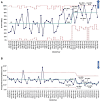Improving Time to First Feeding for Preterm Infants: A Quality Improvement Approach
- PMID: 39980492
- PMCID: PMC11841844
- DOI: 10.1097/pq9.0000000000000798
Improving Time to First Feeding for Preterm Infants: A Quality Improvement Approach
Abstract
Introduction: Early initiation of enteral feeding is reported to reduce sepsis and mortality in preterm infants. Less than half of stable infants born <35 weeks gestational age with birth weight <2,000 g are fed within 24 hours of birth at our center.
Methods: The Specific, measureable, achievable, relevant, timely aim of this quality improvement project was to increase the initiation of enteral feeding within 24 hours of birth from 49% (baseline) to 75% among infants born <35 weeks gestational age with birth weight <2,000 g between November 2022 and December 2023. We identified the unavailability of a mother's own milk as a major barrier to early feeding initiation. Project interventions included antenatal lactation consultation, patient-dedicated breast pumps, standardized feeding orders, and multidisciplinary education. The outcome measure was the time to first enteral feeding, and the balancing measures were the diagnosis of necrotizing enterocolitis (NEC) and the use of formula for first feeding.
Results: The proportion of infants with feeding initiated within 24 hours of birth increased from 49% to 80% during the project period. The incidence of NEC was unchanged (1.9% before and during the project period). Both before and during the project, feedings were most frequently initiated with pasteurized donor human milk (49.7% versus 58.7%), followed by mother's own milk (37.8% versus 35.6%) and formula (12.5% versus 5.8%).
Conclusions: This quality improvement project increased the proportion of eligible infants fed within 24 hours of birth without a change in the incidence of NEC or an increase in formula use as first feeding.
Copyright © 2025 the Author(s). Published by Wolters Kluwer Health, Inc.
Figures



References
-
- Chitale R, Ferguson K, Talej M, et al. . Early enteral feeding for preterm or low birth weight infants: a systematic review and meta-analysis. Pediatrics. 2022;150:e2022057092E. 10.1542/peds.2022–057092E. - PubMed
-
- Ramaswamy VV, Bandyopadhyay T, Ahmed J, et al. . Enteral feeding strategies in preterm neonates ≤32 weeks gestational age: a systematic review and network meta-analysis. Ann Nutr Metab. 2021;77:204–220. - PubMed
-
- Schanler RJ, Shulman RJ, Lau C, et al. . Feeding strategies for premature infants: randomized trial of gastrointestinal priming and tube-feeding method. Pediatrics. 1999;103:434–439. - PubMed
LinkOut - more resources
Full Text Sources
